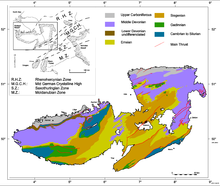- Rhenish Massif
-
The Rhenish Massif (German: Rheinisches Schiefergebirge: "Rhenish Slate Range") is a geologic massif in western Germany, eastern Belgium, Luxembourg and northeastern France.
The Rhenish Massif consists of the Belgian and French Ardennes, the German Eifel and east of the river Rhine the Sauerland and Siegerland. The Mosel and Hunsrück hills form its southwestern part, the Westerwald, Lahn-Dill area and the Taunus occupy the southeastern part. The massif is divided in two by the Middle Rhine Valley, a UNESCO World Heritage area.
Geology
Geologically the Rhenish Massif consists of metamorphic rocks, mostly slates (hence its name), deformed and metamorphosed during the Hercynian orogeny (around 300 million years ago). Most of the massif is part of the Rhenohercynian zone of this orogeny, that also encompasses the Harz further east and Devonian rocks of Cornwall (southwestern England).
Most rocks in the Rhenish Massif were originally sediments, mostly deposited during the Devonian and Carboniferous in a back-arc basin called the Rhenohercynian basin. In some places in the Ardennes, even older rocks of Cambrian to Silurian age crop out as massifs overlain by Devonian slates. These older rocks form smaller massifs of their own (Stavelot, Rocroi, Givonne and Serpont). In the eastern Rhenish Massif some very limited outcrops in the Sauerland show rocks of Ordovician and lower Siliurian age. Further Ordovician rock exposures are part of the southern Taunus.
The second rock type are Tertiary and Quaternary igneous rocks, which most prominently occur in the Vulkaneifel, the Westerwald and the Vogelsberg.
References
- Walter, R. et al.: Geologie von Mitteleuropa. 5. Auflage, Schweizerbarth’sche Verlagsbuchhandlung, Stuttgart 1992. ISBN 3-510-65149-9 (German)
Categories:- North Rhine-Westphalia geography stubs
- Rhineland-Palatinate geography stubs
- Belgium geography stubs
- Luxembourg geography stubs
- Regional geology stubs
- Hills of Germany
- Geology of Germany
- Mountains and hills of North Rhine-Westphalia
- Geography of Rhineland-Palatinate
- Geography of Saarland
- Regions of Hesse
- Rhineland
Wikimedia Foundation. 2010.

